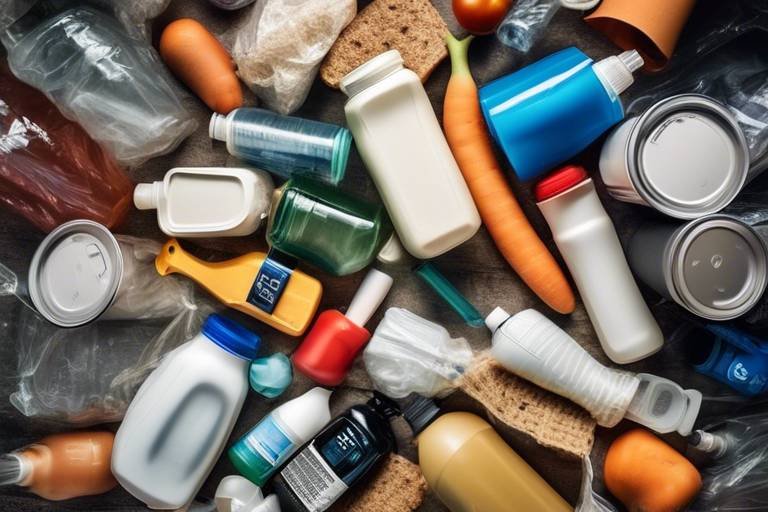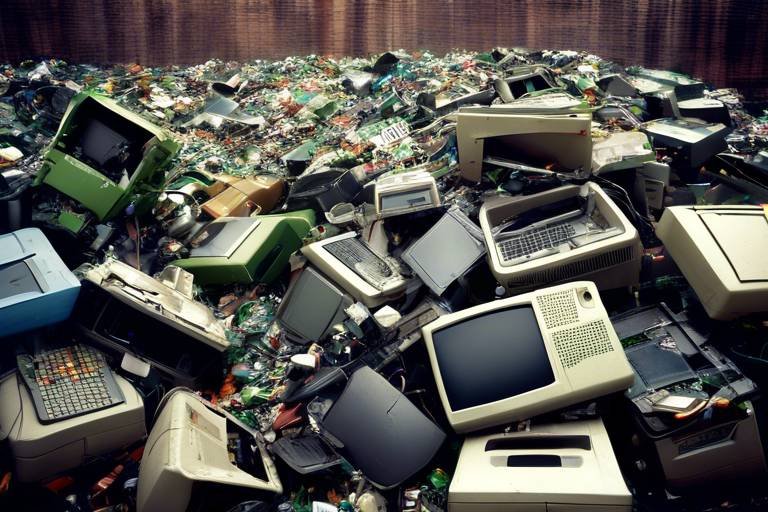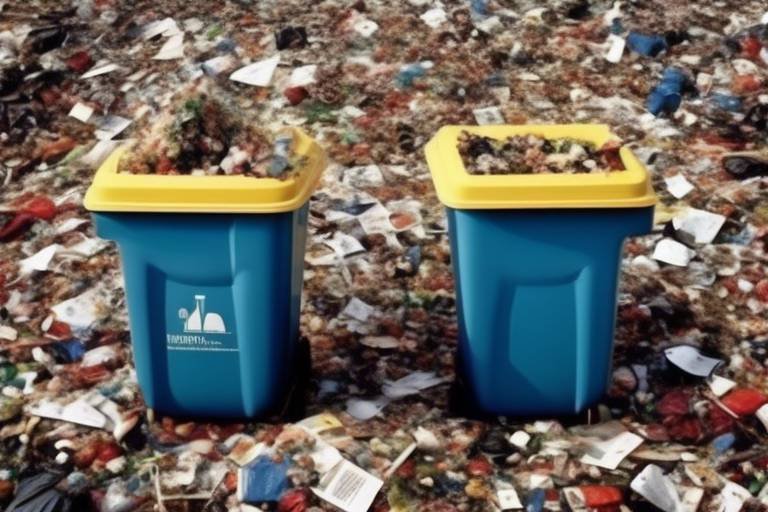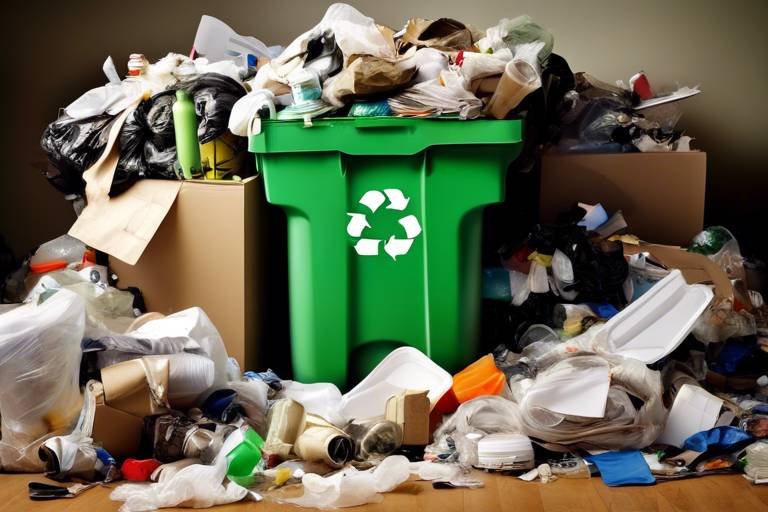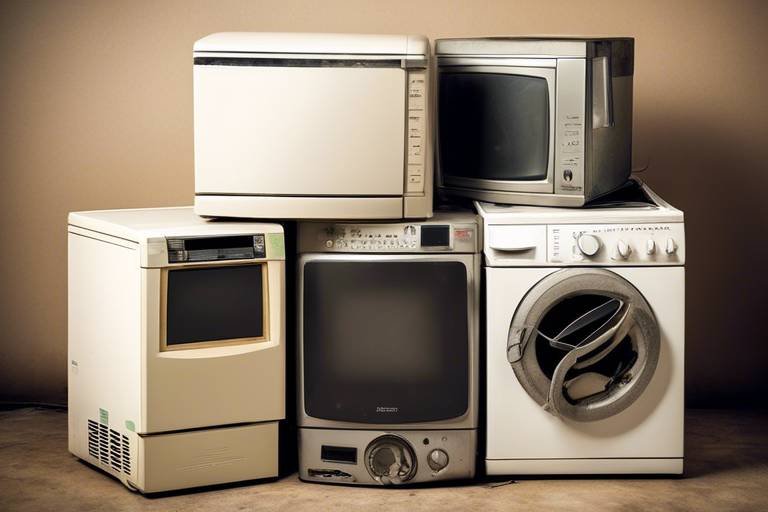Everything You Need to Know About Precycling
In a world where waste seems to be a constant companion, the idea of precycling emerges as a beacon of hope. But what exactly is precycling? It's more than just a trendy buzzword; it's a proactive approach to waste management that encourages individuals and communities to think critically about their consumption habits. Imagine walking through a grocery store, your cart filled with items that not only nourish your body but also respect the planet. That's the essence of precycling—making mindful choices before waste is even created.
Precycling is about reducing waste before it happens. By being selective about what we buy and how it's packaged, we can significantly lessen our environmental footprint. This practice is crucial in today's society, where landfills are overflowing and resources are depleting at an alarming rate. The beauty of precycling lies in its simplicity; it empowers you to take control of your consumption, ensuring that your choices align with your values of sustainability and environmental responsibility.
So, why should you care about precycling? The benefits are numerous and impactful. Not only does it contribute to a cleaner environment, but it also promotes a circular economy—a system where waste is minimized, and resources are reused and recycled. This shift in mindset can lead to profound changes in how we interact with our environment. Think of it as a ripple effect; your small actions can inspire others, creating a wave of positive environmental change.
Moreover, precycling can save you money. When you consciously choose to avoid products with excessive packaging or single-use items, you often find yourself purchasing only what you truly need. This leads to less waste and more savings in your pocket. It's a win-win situation that encourages smarter shopping habits while protecting our planet.
As we delve deeper into the concept of precycling, it's essential to understand its broader implications. The environmental impact of precycling is profound. By preventing waste generation, we can significantly lower pollution levels and conserve precious natural resources. In the following sections, we will explore the specific benefits of precycling, practical tips for incorporating it into your daily life, and the role of community initiatives in promoting this vital practice.
Precycling is the practice of reducing waste before it is created. By making conscious choices about purchases and packaging, individuals can minimize their environmental footprint and promote a sustainable lifestyle.
Precycling offers numerous advantages, including reducing landfill waste, conserving resources, and promoting a circular economy. Understanding these benefits can motivate individuals and businesses to adopt precycling practices.
Precycling significantly lowers pollution and resource depletion by preventing waste generation. This section discusses how precycling contributes to a healthier planet and mitigates climate change effects.
By choosing to precycle, individuals can decrease the amount of waste sent to landfills. This subheading highlights the importance of minimizing landfill contributions and its long-term benefits for the environment.
Precycling helps conserve natural resources by reducing the demand for new materials. This section explains how precycling practices can lead to more sustainable resource management.
Implementing precycling into daily life can be simple and effective. This section provides actionable tips to help individuals start precycling and make a positive impact.
Community initiatives play a crucial role in promoting precycling. This section explores how local organizations and groups can encourage precycling practices among residents.
Workshops can educate community members about precycling benefits and techniques. This subheading discusses the importance of hands-on learning experiences in fostering sustainable habits.
Collaborative projects can amplify precycling efforts. This section highlights successful community partnerships that have effectively promoted precycling and waste reduction initiatives.
- What is the difference between recycling and precycling? Precycling focuses on preventing waste before it occurs, while recycling involves processing waste after it has been created.
- How can I start precycling in my daily life? Begin by evaluating your purchases, opting for products with minimal packaging, and avoiding single-use items.
- Can businesses practice precycling? Absolutely! Businesses can adopt precycling by choosing sustainable packaging options and encouraging customers to bring reusable containers.

What is Precycling?
Precycling is more than just a buzzword; it’s a proactive approach to waste management that focuses on reducing waste before it ever hits the trash bin. Imagine walking into a store and making choices that not only benefit you but also the planet. That’s the essence of precycling! Instead of waiting until after you've consumed a product to think about its waste, precycling encourages you to consider the environmental impact of your purchases right from the start. It’s like being a detective in the world of consumerism, where you analyze every item you buy for its packaging and sustainability.
At its core, precycling is about being mindful. It involves asking yourself critical questions before making a purchase: Is this product necessary? Can I find a version with less packaging? Will this item eventually contribute to landfill waste? By making these conscious decisions, individuals can significantly reduce their environmental footprint. It's akin to planting seeds of sustainability in your daily life, which, over time, can blossom into a more eco-friendly lifestyle.
To put it simply, precycling is all about preventing waste before it even begins. This means opting for products that are reusable, recyclable, or come with minimal packaging. For example, instead of buying a new plastic water bottle every time you’re thirsty, why not invest in a sturdy reusable one? Not only does it save you money in the long run, but it also cuts down on the plastic waste that clogs our oceans and landfills. Precycling encourages a shift in mindset—seeing waste not as an inevitable byproduct of consumption, but as something we can actively avoid.
In practice, precycling can be as simple as:
- Choosing bulk items to reduce packaging waste.
- Bringing your own bags to the grocery store.
- Opting for products made from recycled materials.
- Repairing instead of replacing broken items.
By embedding these practices into your daily routine, you’re not just reducing waste; you’re also promoting a culture of sustainability. Precycling is a powerful tool that empowers individuals to make informed decisions, fostering a sense of responsibility towards our planet. It’s about creating a ripple effect—when one person chooses to precycle, it can inspire friends, family, and even entire communities to follow suit. So, the next time you’re out shopping, think about how your choices can lead to a cleaner, greener future!
Q: How does precycling differ from recycling?
A: Precycling focuses on preventing waste before it is created, while recycling involves processing waste materials after they have been generated.
Q: Can precycling really make a difference?
A: Absolutely! By making conscious purchasing decisions, individuals can significantly reduce the amount of waste sent to landfills and conserve natural resources.
Q: What are some easy ways to start precycling?
A: You can start by choosing products with minimal packaging, using reusable bags, and buying in bulk.

The Benefits of Precycling
Precycling is not just a trendy term; it’s a powerful approach to waste management that can transform our relationship with consumption. By making thoughtful choices before we even purchase items, we can significantly reduce the amount of waste generated in the first place. One of the most compelling benefits of precycling is its ability to reduce landfill waste. When we consciously decide to avoid products with excessive packaging or opt for items made from recycled materials, we are actively participating in a solution that minimizes the burden on our landfills. Every piece of waste that we prevent from entering a landfill is a step toward a cleaner, healthier planet.
Moreover, precycling is a champion of resource conservation. Consider this: every time we choose to buy products that are designed to last or come in minimal packaging, we’re not just saving space in landfills; we’re also conserving precious natural resources. This practice reduces the need for new materials, which in turn lessens the environmental impact associated with resource extraction and processing. For instance, by opting for a reusable water bottle instead of single-use plastic bottles, we’re not just reducing plastic waste; we’re also cutting down on the energy and resources required to produce those bottles in the first place.
Another significant advantage of precycling is its contribution to the circular economy. This economic model emphasizes sustainability by keeping products and materials in use for as long as possible. When individuals and businesses embrace precycling, they help create a system where waste is minimized, and resources are continuously reused. For example, if a company chooses to use recycled materials in its products, it not only reduces waste but also encourages a market where recycled goods are valued. This shift can lead to innovation and the development of new, sustainable practices across various industries.
To put it simply, precycling is a win-win situation. Not only does it help in reducing pollution, but it also fosters a sense of community responsibility. When we all commit to making better choices about our consumption habits, we pave the way for a more sustainable future. The ripple effects of precycling can be profound, inspiring others to join the movement and leading to larger-scale changes in how we view waste and resource management.
In summary, the benefits of precycling extend far beyond individual actions. They encompass environmental protection, resource conservation, and the promotion of a sustainable economy. By adopting precycling practices, we can all contribute to a healthier planet and a more responsible society. It’s not just about reducing what we throw away; it’s about redefining our approach to consumption and making choices that reflect our commitment to sustainability.
- What is precycling? Precycling is the practice of reducing waste before it is created by making conscious purchasing decisions and avoiding unnecessary packaging.
- How does precycling help the environment? It reduces landfill waste, conserves natural resources, and minimizes pollution, contributing to a healthier planet.
- Can precycling be practiced by businesses? Absolutely! Businesses can adopt precycling by using sustainable materials and minimizing packaging in their products.

Environmental Impact
This article explores the concept of precycling, its importance in waste reduction, and practical tips for incorporating it into daily life to promote sustainability and environmental responsibility.
Precycling is the practice of reducing waste before it is created. By making conscious choices about purchases and packaging, individuals can minimize their environmental footprint and promote a sustainable lifestyle.
Precycling offers numerous advantages, including reducing landfill waste, conserving resources, and promoting a circular economy. Understanding these benefits can motivate individuals and businesses to adopt precycling practices.
Precycling significantly lowers pollution and resource depletion by preventing waste generation. When we think about our everyday choices, it's easy to overlook how much waste we create without even realizing it. For instance, the simple act of choosing products with minimal packaging can have a ripple effect on our environment. Imagine walking down the grocery aisle and seeing a plethora of products, each wrapped in layers of plastic. By opting for bulk items or those in eco-friendly packaging, you're not just making a purchase; you're making a statement about sustainability.
Moreover, precycling directly contributes to a healthier planet. It reduces the amount of waste that ends up in landfills, which is crucial because landfills are a significant source of methane, a potent greenhouse gas. The less waste we produce, the less methane is released into our atmosphere, helping to mitigate climate change effects. It's like a domino effect; one small change in our buying habits can lead to monumental shifts in environmental health.
Here are a few key environmental impacts of precycling:
- Lower Pollution Levels: By reducing waste, we decrease the pollution associated with waste disposal and incineration.
- Resource Conservation: Precycling minimizes the need for new materials, which means less mining, drilling, and deforestation.
- Enhanced Biodiversity: A healthier environment leads to better ecosystems, supporting diverse plant and animal life.
In essence, precycling is not just about reducing waste; it's about fostering a sustainable lifestyle that benefits both us and the planet. When we adopt precycling practices, we are investing in a cleaner, greener future. With every conscious choice, we contribute to a larger movement towards environmental responsibility.
By choosing to precycle, individuals can decrease the amount of waste sent to landfills. This is crucial because landfills are overflowing, and many materials take centuries to decompose. Imagine the impact if everyone decided to precycle just one item a day! The cumulative effect could lead to a significant reduction in landfill contributions, promoting a healthier environment for future generations.
Precycling helps conserve natural resources by reducing the demand for new materials. When we choose to buy items that are reusable or made from recycled materials, we are directly influencing resource management. This practice not only helps in conserving resources but also supports the circular economy, where materials are reused and recycled instead of being discarded.
Implementing precycling into daily life can be simple and effective. This section provides actionable tips to help individuals start precycling and make a positive impact.
Community initiatives play a crucial role in promoting precycling. This section explores how local organizations and groups can encourage precycling practices among residents.
Workshops can educate community members about precycling benefits and techniques. This subheading discusses the importance of hands-on learning experiences in fostering sustainable habits.
Collaborative projects can amplify precycling efforts. This section highlights successful community partnerships that have effectively promoted precycling and waste reduction initiatives.
Q: What is the difference between recycling and precycling?
A: Recycling involves processing waste materials to make new products, while precycling focuses on reducing waste before it is created through conscious purchasing decisions.
Q: How can I start precycling in my daily life?
A: You can start by choosing products with minimal packaging, buying in bulk, and opting for reusable items instead of disposable ones.
Q: Can businesses benefit from precycling?
A: Absolutely! Businesses can save costs, improve their sustainability image, and attract environmentally conscious consumers by adopting precycling practices.

Reducing Landfill Waste
When we think about waste, it's easy to imagine a massive landfill overflowing with discarded items. But what if I told you that we have the power to change that narrative? is not just a noble goal; it's a necessary action we can take to protect our planet. By embracing the concept of precycling, we can significantly decrease the volume of waste that ends up in landfills. How, you ask? Well, let’s dive into this.
First and foremost, precycling encourages us to consider the life cycle of the products we buy. Every time we make a purchase, we should ask ourselves: Is this item going to contribute to waste? By choosing products with minimal or no packaging, or opting for items made from recycled materials, we are already taking steps to reduce the waste we create. For example, instead of buying individually wrapped snacks, why not purchase bulk items and use your own reusable containers? This simple switch not only cuts down on packaging waste but also saves you money in the long run!
Moreover, it’s crucial to understand the impact of our choices on landfill contributions. Did you know that food waste alone accounts for nearly 22% of landfill waste? By planning meals and using leftovers creatively, we can drastically reduce this percentage. Composting is another fantastic solution; it allows organic waste to decompose naturally, turning it into nutrient-rich soil instead of contributing to the ever-growing landfills. Imagine transforming your kitchen scraps into a garden treasure!
Another effective strategy is to prioritize quality over quantity. Investing in durable, long-lasting products means fewer items in the landfill over time. Think about it: buying a high-quality backpack that lasts for years instead of several cheaper ones that wear out quickly is not just a cost-effective choice, but it also minimizes waste. Every small decision counts when it comes to reducing landfill waste.
Finally, let’s not forget about sharing and donating. If you have items that you no longer need but are still in good condition, consider giving them a second life by donating them to local charities or community centers. This not only helps those in need but also keeps those items out of landfills. It’s a win-win situation!
In summary, reducing landfill waste through precycling is an achievable goal that requires mindful decision-making and a commitment to sustainability. By being conscious of our purchases, planning meals, investing in quality, and sharing with others, we can all play a significant role in minimizing waste and protecting our environment. So, the next time you’re about to toss something in the trash, pause for a moment and think: Is there a better way?
- What is precycling? Precycling is the practice of reducing waste before it is created by making conscious choices about purchases and packaging.
- How can I start precycling? Begin by assessing your buying habits, choosing products with less packaging, and planning meals to avoid food waste.
- What are the environmental benefits of reducing landfill waste? It helps lower pollution, conserves resources, and contributes to a healthier planet.

Conserving Resources
When we talk about precycling, one of the most significant advantages is its role in . Imagine a world where we don’t just recycle the materials we use but actively prevent waste before it even happens. That’s the essence of precycling! By making thoughtful choices about what we buy and how we use products, we can significantly reduce the demand for new materials. This not only helps the environment but also saves money in the long run.
To grasp the impact of precycling on resource conservation, consider this: every item we purchase often requires energy, water, and raw materials to produce. From the extraction of natural resources to manufacturing processes, the environmental toll is substantial. By choosing products with minimal packaging or opting for reusable items, we can reduce the strain on our planet’s resources. For instance, when you decide to buy in bulk, you’re not just saving money; you’re also cutting down on the amount of packaging waste generated.
Here are a few practical ways precycling helps conserve resources:
- Reducing the Need for Raw Materials: By minimizing purchases and opting for second-hand items, we lessen the demand for new products, which in turn decreases the need for resource extraction.
- Energy Conservation: Every product we create requires energy, often derived from fossil fuels. By reducing our consumption, we can significantly lower energy usage.
- Water Savings: The production of goods often consumes vast amounts of water. Precycling helps to mitigate this by reducing the overall quantity of products produced.
Additionally, precycling encourages a shift in mindset. Instead of viewing products as disposable, we start to see them as valuable resources that should be used to their fullest potential. This change in perspective can lead to innovative practices such as repairing instead of replacing, sharing instead of owning, and upcycling materials for new uses. For example, turning an old t-shirt into a reusable shopping bag not only keeps it out of the landfill but also reduces the demand for new textiles.
In essence, conserving resources through precycling is a win-win situation. It empowers us as consumers to make informed decisions that benefit our pockets and the planet. By embracing this proactive approach, we can foster a sustainable future where resources are cherished, and waste is minimized. So, the next time you’re about to make a purchase, ask yourself: Is there a way I can precycle this item? Your choices today can lead to a healthier planet tomorrow!
What is precycling?
Precycling is the practice of reducing waste before it is created by making conscious choices about purchases and packaging.
How does precycling help the environment?
By preventing waste generation, precycling significantly lowers pollution and resource depletion, contributing to a healthier planet.
Can precycling save me money?
Yes! By buying in bulk, choosing reusable items, and reducing unnecessary purchases, you can save money while also helping the environment.
What are some simple ways to start precycling?
You can start precycling by opting for products with minimal packaging, choosing second-hand items, and using reusable bags and containers.

Practical Tips for Precycling
This article explores the concept of precycling, its importance in waste reduction, and practical tips for incorporating it into daily life to promote sustainability and environmental responsibility.
Precycling is the practice of reducing waste before it is created. By making conscious choices about purchases and packaging, individuals can minimize their environmental footprint and promote a sustainable lifestyle.
Precycling offers numerous advantages, including reducing landfill waste, conserving resources, and promoting a circular economy. Understanding these benefits can motivate individuals and businesses to adopt precycling practices.
Precycling significantly lowers pollution and resource depletion by preventing waste generation. This section discusses how precycling contributes to a healthier planet and mitigates climate change effects.
By choosing to precycle, individuals can decrease the amount of waste sent to landfills. This subheading highlights the importance of minimizing landfill contributions and its long-term benefits for the environment.
Precycling helps conserve natural resources by reducing the demand for new materials. This section explains how precycling practices can lead to more sustainable resource management.
Implementing precycling into daily life can be simple and effective. The first step toward precycling is to become more mindful of your purchasing habits. Before making a purchase, ask yourself: "Do I really need this?" and "How will this item impact the environment?" This kind of reflection can help you avoid unnecessary purchases that contribute to waste.
Another practical tip is to opt for products with minimal or no packaging. For example, when shopping for groceries, consider bringing your own reusable bags and containers. Not only does this reduce waste, but it also encourages stores to offer more sustainable options. Additionally, you can support local farmers and markets that focus on minimal packaging by buying fresh produce directly from them.
Consider making a habit of choosing items that are reusable or recyclable. For instance, instead of single-use plastic utensils or plates, invest in a set of durable, reusable ones. This small shift can have a significant impact over time. Furthermore, it's beneficial to educate yourself about the recycling policies in your area, as this knowledge empowers you to make better choices about what to buy and how to dispose of it responsibly.
Lastly, don't underestimate the power of community. Engaging with local groups focused on sustainability can provide you with valuable resources and support. For example, you might find workshops on precycling practices that help you learn new techniques and share ideas with like-minded individuals. By working together, communities can amplify their precycling efforts and inspire others to join the movement.
Community initiatives play a crucial role in promoting precycling. This section explores how local organizations and groups can encourage precycling practices among residents.
Workshops can educate community members about precycling benefits and techniques. This subheading discusses the importance of hands-on learning experiences in fostering sustainable habits.
Collaborative projects can amplify precycling efforts. This section highlights successful community partnerships that have effectively promoted precycling and waste reduction initiatives.
Q: What is the difference between recycling and precycling?
A: Recycling involves processing used materials to create new products, while precycling focuses on reducing waste before it is created by making conscious purchasing decisions.
Q: How can I encourage my friends and family to precycle?
A: Lead by example! Share your precycling practices and the benefits you've experienced. You can also organize fun group activities, like a precycling challenge, to motivate others.
Q: Are there any apps that can help with precycling?
A: Yes! There are several apps designed to help users track their waste and find sustainable products. Look for apps that offer local recycling information and tips on reducing waste.

Precycling in the Community
Community initiatives play a crucial role in promoting precycling. When people come together, the impact can be monumental. Imagine a neighborhood where everyone is committed to reducing waste before it even begins—sounds like a dream, right? Well, it’s entirely possible! Local organizations and groups can spearhead efforts to encourage precycling practices among residents, fostering a culture of sustainability that ripples through the community.
One of the most effective ways to engage the community is through organizing workshops. These workshops can serve as a platform to educate community members about the benefits of precycling and the techniques they can use in their daily lives. Think of it as a hands-on learning experience where individuals can see the tangible effects of their choices. For instance, participants can learn how to identify products with minimal packaging or how to make informed decisions at the grocery store. By providing practical tips and real-life examples, these workshops can empower residents to make a difference.
Another powerful approach is through collaborative efforts. When local businesses, schools, and non-profits join forces, the potential for impact multiplies. Consider a scenario where a local grocery store partners with a community group to offer discounts on bulk purchases, encouraging residents to buy in larger quantities and reduce packaging waste. This not only benefits the consumers but also promotes a culture of sustainability within the marketplace. Collaborative projects can also include community clean-up days, where participants are encouraged to bring their own containers for snacks and drinks, further emphasizing the importance of precycling.
To illustrate the impact of community initiatives, here’s a quick look at some successful precycling projects:
| Project Name | Description | Impact |
|---|---|---|
| Green Neighborhood Initiative | A series of workshops focused on reducing packaging waste. | Decreased local landfill contributions by 30% over a year. |
| Community Swap Day | Event where residents can exchange items instead of throwing them away. | Promoted reuse and reduced waste generation significantly. |
| Local Business Partnerships | Collaboration with stores to promote bulk buying. | Increased awareness of sustainable purchasing choices. |
As you can see, these initiatives not only educate but also create a sense of community spirit. When individuals see their neighbors actively participating in precycling efforts, it inspires them to join in. It’s like a chain reaction—one small effort can lead to a wave of change. So, whether it’s through workshops, collaborative projects, or simple community gatherings, the message is clear: precycling is a community affair.
- What is precycling? Precycling is the practice of reducing waste before it is created by making conscious choices about purchases and packaging.
- How can I get involved in precycling in my community? Look for local workshops, community clean-up events, or organizations focused on sustainability.
- What are some simple precycling practices I can implement? Start by choosing products with less packaging, bringing your own bags when shopping, and opting for bulk purchases.

Organizing Workshops
Organizing workshops is a fantastic way to bring the community together and foster a deeper understanding of precycling. These hands-on learning experiences not only educate participants about the importance of reducing waste before it even occurs but also inspire them to adopt sustainable habits in their daily lives. Imagine a gathering where people share ideas, learn practical skills, and collaborate on solutions to tackle waste issues in their neighborhoods. Sounds engaging, right?
Workshops can cover a variety of topics related to precycling, such as:
- Understanding Precycling: Explain what precycling is and why it matters.
- Identifying Wasteful Practices: Help participants recognize their own habits that contribute to waste.
- Practical Tips: Offer actionable strategies for reducing waste in purchasing decisions.
- Creative Reuse: Demonstrate how to repurpose items instead of discarding them.
Moreover, these workshops can be tailored to different audiences. For instance, schools can host sessions for students to learn about precycling through fun activities, while local businesses might benefit from workshops focused on sustainable practices that can be integrated into their operations. The key is to make these workshops interactive and engaging, encouraging participants to share their experiences and insights.
To ensure the success of these workshops, organizers should consider several factors:
- Location: Choose a venue that is accessible and comfortable for participants.
- Promotion: Use social media, flyers, and community boards to spread the word.
- Materials: Provide necessary supplies, such as handouts, tools for demonstrations, and recycling bins.
- Follow-Up: Encourage participants to share their progress and experiences after the workshop, fostering a sense of community.
By organizing workshops, communities can create a ripple effect, where knowledge and enthusiasm for precycling spread beyond the event itself. Participants leave empowered, equipped with the tools and inspiration to make a difference. This communal approach not only strengthens relationships among residents but also builds a culture of sustainability that can lead to long-lasting change. So, why not take the initiative to organize a workshop in your area? You could be the spark that ignites a movement towards a more sustainable future!
Q: What is the main goal of precycling workshops?
A: The primary goal is to educate participants about the concept of precycling and provide practical strategies to reduce waste before it is created.
Q: Who can benefit from attending these workshops?
A: Anyone interested in sustainability can benefit, including individuals, families, students, and local business owners.
Q: How can I organize a precycling workshop in my community?
A: Start by gathering a group of interested individuals, choose a suitable location, plan the content, and promote the event through various channels.
Q: Are there any costs associated with organizing a workshop?
A: While there may be some costs for materials and venue rental, many community centers offer free or low-cost spaces, and you can often source materials through donations.

Collaborative Efforts
When it comes to precycling, the power of community collaboration cannot be overstated. Imagine a vibrant neighborhood where residents band together, sharing resources and knowledge to reduce waste before it even hits the bins. This collective approach not only amplifies the impact of precycling but also fosters a sense of belonging and responsibility among participants. By pooling together ideas and strategies, communities can create innovative solutions that benefit both the environment and their local economies.
One successful example of collaborative efforts in precycling is the establishment of community swap events. These gatherings allow individuals to exchange items they no longer need, such as clothing, furniture, or household goods, thereby extending the lifecycle of products and reducing the demand for new purchases. Not only do these events help in waste reduction, but they also promote social interaction and strengthen community ties. Residents leave with new treasures while keeping usable items out of landfills—it's a win-win!
In addition to swap events, local organizations can initiate educational programs that focus on the principles of precycling. Workshops can be organized to teach residents about making sustainable choices, such as selecting products with minimal packaging or opting for reusable alternatives. These hands-on learning experiences can empower individuals to make informed decisions that contribute to a healthier planet. For instance, a local group might host a workshop on creating DIY cleaning products using everyday household items, effectively reducing reliance on single-use plastic containers.
Moreover, collaborative projects can extend beyond individual households. Businesses and local governments can partner to implement precycling initiatives at a larger scale. For example, a city might work with local grocery stores to establish a bring your own container program, encouraging shoppers to use their own bags and containers instead of disposable ones. Such initiatives not only reduce waste but also set a precedent for sustainable practices within the community.
To truly maximize the benefits of collaborative precycling efforts, it's essential to maintain open lines of communication among all stakeholders. Regular meetings and feedback sessions can help identify challenges and successes, allowing communities to adapt their strategies effectively. By celebrating milestones and sharing progress, communities can inspire others to join the movement, creating a ripple effect that can lead to significant environmental change.
- What is precycling? Precycling is the practice of reducing waste before it is created by making conscious choices about purchases and packaging.
- How can I start precycling in my daily life? You can start by choosing products with less packaging, opting for reusable items, and participating in community swap events.
- Why is community collaboration important for precycling? Collaborative efforts amplify the impact of precycling, foster community spirit, and create innovative solutions to waste reduction.
- Are there any successful examples of precycling initiatives? Yes, community swap events, educational workshops, and partnerships between local businesses and governments are all successful examples.
Frequently Asked Questions
- What is the main goal of precycling?
The main goal of precycling is to minimize waste before it is created. By making thoughtful choices about what we buy and how products are packaged, we can significantly reduce our environmental impact and promote a more sustainable lifestyle.
- How does precycling benefit the environment?
Precycling benefits the environment by reducing the amount of waste that ends up in landfills, conserving natural resources, and lowering pollution levels. By preventing waste generation, we contribute to a healthier planet and combat climate change.
- Can businesses practice precycling?
Absolutely! Businesses can adopt precycling by choosing sustainable packaging, reducing excess materials, and encouraging their customers to make conscious purchasing decisions. This not only helps the environment but can also enhance their brand image.
- What are some simple ways to start precycling at home?
Starting precycling at home can be easy! Here are a few tips:
- Opt for products with minimal or no packaging.
- Bring your own reusable bags when shopping.
- Choose bulk items to reduce packaging waste.
- Repurpose containers instead of throwing them away.
- How can communities promote precycling?
Communities can promote precycling through workshops, educational programs, and collaborative projects that encourage residents to adopt sustainable practices. Local organizations can play a vital role in spreading awareness and providing resources.
- What is the difference between recycling and precycling?
Recycling involves processing used materials to create new products, while precycling focuses on reducing waste before it occurs. Essentially, precycling is about making smarter choices to prevent waste, whereas recycling is about managing waste that has already been created.
- Are there any resources available for learning more about precycling?
Yes! There are numerous resources available, including websites dedicated to sustainability, local environmental organizations, and community workshops. These resources can provide valuable information on how to effectively incorporate precycling into your daily life.


